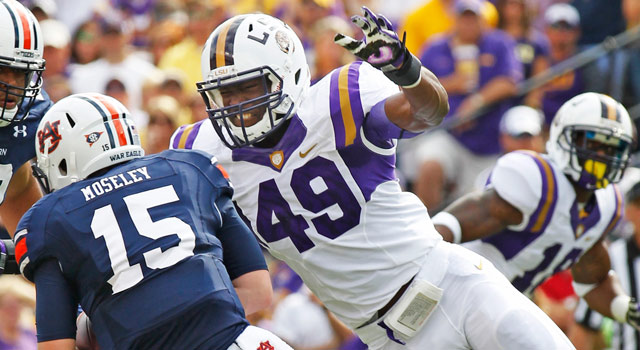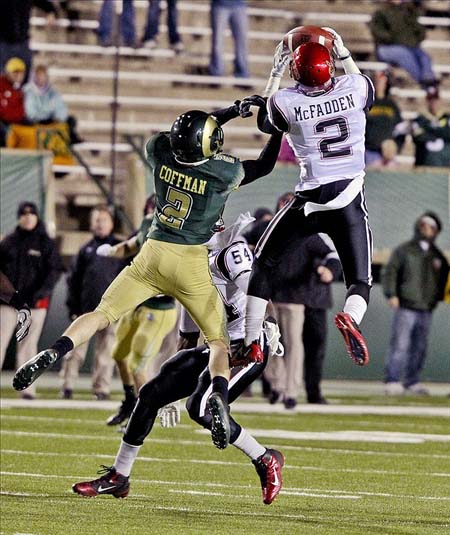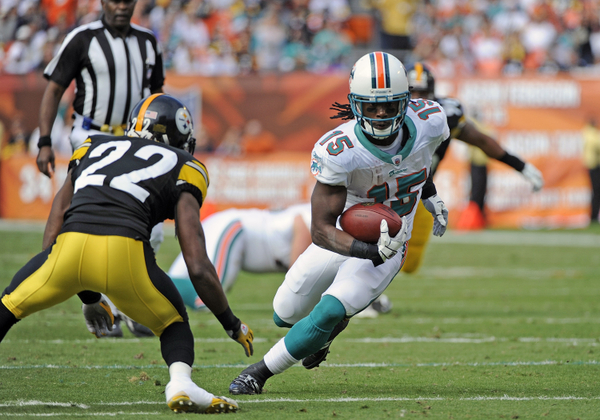 Browns Archive
Browns Archive  The Browns Had an Interesting Weekend at the NFL Draft
The Browns Had an Interesting Weekend at the NFL Draft
 The Cleveland Browns had an “interesting” weekend during the three-day NFL Draft – and that may be understating things a bit.
The Cleveland Browns had an “interesting” weekend during the three-day NFL Draft – and that may be understating things a bit.
Once all seven rounds were completed, the Browns turned their seven draft picks into outsider linebacker Barkevious Mingo, cornerback Leon McFadden, safety Jamoris Slaughter, defensive end Armonty Bryant, offensive tackle Garrett Gilkey and a bucket load of draft picks in the 2014 NFL Draft. And they added veteran wide receiver Davone Bess in a trade with Miami
It was quite the weekend, so let's recap what happened.
Mingo the Merciless
Mingo is an interesting pick as an edge rusher out of LSUA. At 237 pounds, he is pretty light by NFL standards. And while he will probably add on some pounds over the next few years, he will never be a Paul Kruger (270 pounds) or Terrell Suggs (260) size linebacker. (James Harrison did pretty well in Pittsburgh playing at 240 pounds. Although he is four inches shorter than Mingo).
“I think I could play at this weight right here,” Mingo said in his introductory news conference. “A lot of people have been telling me you need to be heavier to be in the NFL, ‘You’ve got to be 20 pounds heavier.’ I actually played lighter some years in my college career and did absolutely fine. I weigh more than I did in college and I don’t think it will be too much of an adjustment to make.”
What Mingo may lack in size he makes up for intensity.
“At LSU I played with a high motor. I wanted to get (in the backfield),” he said. “Every play I want to get a sack, I wanted to be in the back field. Just having that mindset I guess helps everything else.”
The other knock against Mingo is that his stats at LSU didn’t “match up” to his talents. He totaled 60 tackles and 15 sacks in 40 games, making just 15 starts. His sack total dropped from eight as a sophomore to four-and-a-half last season.
But pressuring the opposing quarterback isn’t all about sacks – it’s also about disrupting the quarterback’s rhythm, making him go to his check down receiver rather than throw down field, tipped passes and generally making the quarterback as uncomfortable as possible. In college, Mingo had 27 quarterback hits and four forced fumbles; we’re pretty sure he knows where the quarterback is.
In addition, LSU coach Les Miles wants his defensive ends to hold the edge, rather than chase sacks, so they don’t get burned – something that is becoming increasingly important as more NFL teams run variations of the read-option offense.
And let’s not forget that Mingo played in the SEC – probably the closest conference in college football to the AFC North.
With Mingo, the Browns now have a defensive front seven rotation where D’Qwell Jackson is the oldest player at 29.
Somebody Has to Cover
While the Browns are clearly embracing a defensive philosophy that emphasizes giving the opposing quarterback as little time as possible to throw the ball, someone does have to cover the wide receivers when they go out for a pass.
 Enter Leon McFadden, the team’s third-round pick out of San Diego State.
Enter Leon McFadden, the team’s third-round pick out of San Diego State.
McFadden was a member of the All-Mountain West for three consecutive years, which is nice. As a senior, he had 61 tackles and three interceptions. He reportedly has quick feet, good speed and “fluid hips” (a must have, don’t you know). NFL.com compares him to Brent Grimes, one of the best corner backs in the NFL before he blew out his Achilles tendon last year with Atlanta.
So why did McFadden last until the third round? Well he’s only 5-foot-9 and 163 pounds (two inches shorter and 27 pounds lighter than Joe Haden, who is not exactly a larger corner back himself). That lack of size means that McFadden can have problems with bigger, physical wide receivers.
That may not be as big of an issue against Pittsburgh (Antonio Brown is 5-10, 186 pounds, and Emmanuel Sanders is 5-11, 180 pounds) or perhaps Cincinnati (Andrew Hawkins is 5-7, 180 pounds and Haden will cover the 6-foot-4 A.J. Green), but McFadden could have matchup problems when the Browns face the Ravens, who can line up Jacoby Jones (6-2, 220) and Torrey Smith (6-0, 205).
“I really don’t look at it as a problem. I’m a competitor,” McFadden said in his introductory press conference. “I don’t think my height has anything to do with my competitiveness or playing. Staying attentive to my technique, playing my game and being competitive out there – that’s what it comes down to, how competitive you want to be in between the lines. That’s something I’m looking forward to. The challenges, different types of challenges.”
McFadden’s father, Leon, played nine seasons of professional baseball, appearing in 62 games for Houston from 1968 through 1970. (And no, he was not a teammate of Brandon Weeden in the minor leagues).
And Somebody Has to Catch
The Browns flipped fourth- and fifth-round draft picks with Miami in a trade for fifth-year wide receiver Davone Bess, who will add depth to a receiving group that is suddenly looking interesting.
 Bess caught 61 passes for 778 yards last season for the Dolphins and had career highs in receptions (79), yards (820) and touchdowns (five) in 2010. He has averaged 64 receptions and almost 690 receiving yards a season.
Bess caught 61 passes for 778 yards last season for the Dolphins and had career highs in receptions (79), yards (820) and touchdowns (five) in 2010. He has averaged 64 receptions and almost 690 receiving yards a season.
Most importantly, he has 130 third-down receptions, the second most in the NFL over the past five seasons. If he understands the importance of running a seven-yard pattern on third-and-six, then he will be a major improvement of Mohamed Massaquoi.
“Davone is a proven receiver who has been extremely productive throughout his career,” Browns coach Rob Chudzinski said on the team’s website. “He possesses outstanding hands and separation skills, while also showing the ability to pick up yards in key situations. Because of his talent and experience, we feel as though he can come in and help us right away.”
The addition of Bess, who the Browns reportedly gave a three-year contract extension on Saturday, gives the Browns a nice group of wide receivers, as he joins incumbents Greg Little, Josh Gordon and Travis Benjamin, along with David Nelson, who was signed in free agency and is currently rehabbing an ACL injury.
Quite an improvement from the days of Massaquoi, Brian Robiskie and Chansi Stuckey.
As for the Rest of the Weekend
Saturday’s nice weather may have been too big of a lure for CEO Joe Banner, and he may have opted to take the day off (or maybe just take a nap) and let general manager Mike Lombardi take over.
How else to explain that the Browns traded their fourth-round pick to Pittsburgh in exchange for the Steelers third-round pick next season, and then traded their fifth-round pick to Indianapolis for the Colts fourth-round pick in 2014.
Apparently Lombardi was so excited to be back in a draft room that he forgot the fundamental purpose of the draft is to actually select players.
When the Browns finally decided it was time to join Saturday’s festivities, they selected Notre Dame safety Jamoris Slaughter in the sixth round. Slaughter only played three games as a senior before tearing his Achilles tendon.
The Browns had two picks in the seventh round. With their first they selected Armonty Bryant out of East Central in Oklahoma. According to NFL.com, Bryant only played in eight games as a senior, as he was suspended after being arrested for selling marijuana to an undercover police officer. He still managed to total 54 tackles (17.5 for loss), 10.5 sacks, four forced fumbles, and two blocked kicks.
With their final pick, the Browns selected offensive tackle Garrett Gilkey from Chadron State (wherever that is). According to NFL.com, he decided to attend Chadron State after taking a 14-hour trip to visit the campus. Maybe he just didn’t want to make the return trip home and just decided to stay.
The Media Did Not Approve This Message
One of the biggest takeaways from this weekend is how much of a disconnect there is between the Cleveland media (and in some cases the national media) over what they perceive to be going on in Berea as opposed to what is actually happening.
After weeks of hearing that the Browns were going to:
- Draft West Virginia quarterback Geno Smith at No. 6
- Trade the No. 6 pick to New England for quarterback Ryan Mallett
- Trade down from No. 6 and miss out on drafting an “impact player”
It turns out the Browns did none of those things. Instead, they determined where they needed help on the team and drafted accordingly. Would we have liked to see them use that fourth-round pick? Sure. But any pick from the fifth round on is just special teams players and guys barely hanging onto a roster spot, so trading away a late pick for a better slot next year can’t be all that bad.
In addition, as soon as Philadelphia drafted quarterback Matt Barkley, we joked on Twitter that the Browns were now compelled to make a trade for Eagles backup quarterback Nick Foles because the Eagles will “have to trade him.”
Sure enough, within a few minutes this showed up on Twitter.
There is also the concern that the players selected with the picks the Browns traded away (Shamarko Thomas by Pittsburgh; Montori Hughes by the Colts) will come back to “haunt” the Browns. Of course, there’s no way of knowing if the Browns would have actually selected those players, or if they would have fit in Ray Horton’s defense, so how anyone can say they will “haunt” the Browns is a stretch.
But just to be safe, Banner may want to keep the Ghostbusters on speed dial.
What Does It All Mean?
Would we have liked to see the Browns select more players? Yes. The more players you pick the more chance you have of finding someone good.
But if the front office decided it was better to acquire some picks for down the road rather than select a player just for the sake of picking someone, then that may not be a bad way to go.
Mingo should be the real deal, and with Jabaal Sheard, Kruger and Quentin Groves in the rotation at outside linebacker, he won’t have to carry the water all by himself.
Hopefully McFadden can hold up and give the Browns some more depth in the defensive backfield.
And it’s not just the two of them; by selecting Gordon last year in the supplemental draft, the Browns accelerated his development and the addition of Bess helps the wide receiver group.
Are these moves going to shoot the Browns into the playoffs in 2013? No.
Did the moves the Browns made this weekend make sense (for the most part)? Yes.
And while it may be setting the bar too low, when it comes to draft day, seeing the Browns make sense is a nice change of pace.
- NBA Announces 2013-2014 Schedule
- Browns Ink Sharknado
- Sharknado A No-Show For Rookie Camp
- Trent Richardson Out Until Training Camp
- Browns Sign Brandon Jackson
- Carrasco Suspended Eight Games
- Browns Add to Wide Receiver Depth with David Nelson
- Browns Need to Learn from Past Draft Mistakes
- Browns Release Chris Gocong and Usama Young
- Browns Missing on Grimes Disappointing, But Not The End
The TCF Forums
- Official- Browns Coach Search/Rumors
HoodooMan (Tuesday, January 21 2014 1:36 PM) - Movies coming out
rebelwithoutaclue (Tuesday, January 21 2014 12:56 PM) - 2015 Recruiting
jclvd_23 (Tuesday, January 21 2014 12:38 PM) - The 2014 Offseason Thread
Larvell Blanks (Tuesday, January 21 2014 12:25 PM) - Chris Grant's first 3 drafts
Kingpin74 (Tuesday, January 21 2014 10:13 AM) - Mike Brown
YahooFanChicago (Monday, January 20 2014 11:15 PM) - 2014 Hoops Hockey Hijinx
jpd1224 (Monday, January 20 2014 4:44 PM) - 2014 Recruiting
jclvd_23 (Monday, January 20 2014 2:26 PM) - Wish List - #4 Pick
Hikohadon (Monday, January 20 2014 1:26 PM) - #1 overall pick Anthony Bennett
TouchEmAllTime (Sunday, January 19 2014 1:28 PM)


